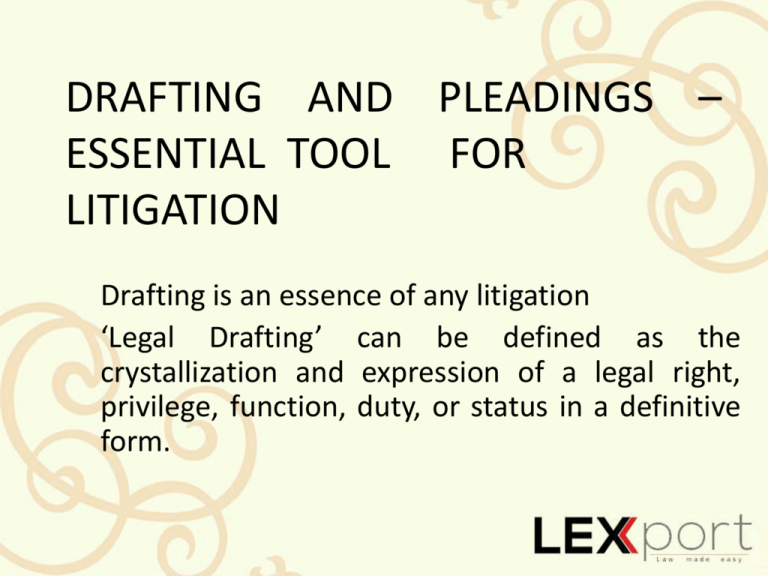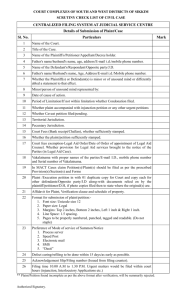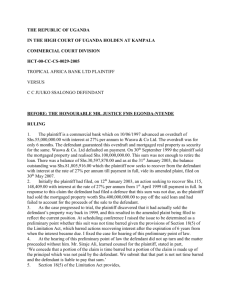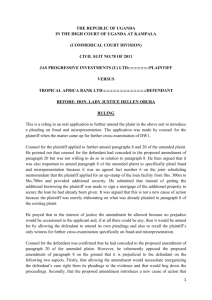drafting and pleadings
advertisement

DRAFTING AND PLEADINGS – ESSENTIAL TOOL FOR LITIGATION Drafting is an essence of any litigation ‘Legal Drafting’ can be defined as the crystallization and expression of a legal right, privilege, function, duty, or status in a definitive form. Legal Drafting generally implies: • Drafting of a deed, instrument or a document, • Embodiment as an agreement between parties, • Intended to regulate the relationship between those parties. IMPORTANCE OF DRAFTING IN LITIGATION : It helps in meeting the client’s goal and carry out the client’s instructions. It helps in maintaining the standard of care which protects the interests of the client. It helps in accurately addressing all the relevant legal and factual issues. Precedents form an essential part of drafting and the same can be very helpful in litigation The Process of drafting operates in two Planes: First thinking and Second composing Two important rules of Legal Drafting are : 1 • • 2 • • • ‘Ordinary sense’ of words : Ensure that words and phrases have been used in their normal and ordinary sense. The meaning of an ordinary English word is a question of fact and needs to be adhered to. ‘Consistent Terminology’: Ensure that each recurring word or term has been used consistently. Do not change your language unless you wish to change the meaning, but always change the language if you wish to change your meaning. It is also an elementary rule that the same word cannot have two different meanings in the same document, unless the context compels the adoption of such a course. PRE-REQUISTES OF LEGAL DRAFTING • A proper understanding of drafting cannot be realized unless the nexus between the law, facts, and the language is fully understood and accepted. OF SESSION - Mukul Chandraand • Draft should be free from ambiguity Associate Partner Lexport doubtful connotation . • Nothing is to be omitted or admitted at random. END Fowlers five rules of drafting According to Fowler there are five rules of drafting which are as under : To be Direct; Simple; Brief; Vigorous; and lucid. Types of Legal Drafting Functional • This type of drafting is intended to achieve a particular result, and usually defines and regulates the legal relationship between two or more parties. • Examples: sale deeds, mortgage deeds, Gifts and wills. Persuasive • The layout of a persuasive draft is usually dictated by the line of arguments intended to emanate from the document and is designed to convince the reader to accept a certain viewpoint. • Examples: Plaints, Written Statements, Memorandums of Appeal, and Bail Applications. Informative • Such drafts normally only contain the information necessary and useful for the reader. • Examples: Letters to Client, and Legal Opinions. Three Stages in Legal Drafting The Planning stage The Writing Stage Revision Stage The Planning Stage • Take instructions from the client • Analyze those instructions and compartmentalize them in a factual and legal context. • Ascertain the purpose and objective behind creating the document. • Research the relevant up-to-date law and form appropriate forms or precedents. • Identify options The Writing Stage • Prepare a skeleton draft • Create ideas for the draft • Ensure that all the content conceived during the Planning stage has been incorporated in the draft Revision Stage • Re-analyze the instructions, factual situation • Re-write to ensure coherence; • Re-organize the material in a clear and user friendly manner; • Edit the material; • Concentrate on spelling and grammar. Principles of interpretation : construction and Every Competent draftsperson must keep the principles of construction and interpretation in mind while preparing a draft. Principles of interpretation are important because they demonstrate how courts approach the draft in order to ascertain its true intent. Some of these rules of interpretation are : Noscitur a sociis ( A word is known by the company it keeps) • This rule is used to construe words with reference to words found in immediate connection with them. This is a contextual principle whereby a word or phrase is not to be construed as it stands alone, but in the light of its surroundings. Ejusdem Generis (of the same kinds, class or nature) • Where a list of two or more items belonging to the same genus is followed by general words, the general words are construed as confined to the same class. By virtue of this principle, wide words associated in the text with more limited words are taken to be restricted by implication to the matters of the same limited character. The ejusdem generis principle however , applies only when a contrary intention does not appear. Expressio unis est exclusio alterius ( The expression of one thing is the exclusion of another) • It is applied where a provision may have covered a number of matters but in fact mentions only some of them. Unless these are mentioned as examples, or not mentioned for some other sufficient reason, the rest are taken to be excluded from the proposition. Noscitur a sociis ( A word is known by the company it keeps) • This rule is used to construe words with reference to words found in immediate connection with them. This is a contextual principle whereby a word or phrase is not to be construed as it stands alone, but in the light of its surroundings. Ejusdem Generis (of the same kinds, class or nature) • Where a list of two or more items belonging to the same genus is followed by general words, the general words are construed as confined to the same class. By virtue of this principle, wide words associated in the text with more limited words are taken to be restricted by implication to the matters of the same limited character. The ejusdem generis principle however , applies only when a contrary intention does not appear. Expressio unis est exclusio alerius ( The expression of one thing is the exclusion of another) • It is applied where a provision may have covered a number of matters but in fact mentions only some of them. Unless these are mentioned as examples, or not mentioned for some other sufficient reason, the rest are taken to be excluded from the proposition. Some Do’s and Don’ts for drafting any legal document: • 1. 2. 3. 4. 5. 6. 7. 8. 9. 10. Do’s Reduce the group of words to single 1. word; Use simple verb for a group of words; 2. Avoid round-about construction; Avoid unnecessary repetition; Write shorter sentences; 3. Express the ideas in fewer words; Prefer the active to the passive voice 4. sentences; Choose the right word; 5. Know exactly the meaning of the words and sentences you are writing; and Put yourself in the place of reader, read the document and satisfy yourself about the content, interpretation and the sense it carries • Don’ts Avoid the use of words of same sound. For example, the words “Employer” and “Employee” When the clause in the document is numbered it is convenient to refer to any one clause by using single number for it. For example, “in clause 2 above” and so on. Negative in successive phrases should be very carefully employed. Draftsman should avoid the use of words “less than” or “more than”, instead he must use “not exceeding”. If the draftsman has provided for each of the two positions to happen without each other and also happen without, “either” will not be sufficient; he should write “either or both” or express the meaning of the two in other clauses. To sum up, the draftsman should bear in mind the following principles of drafting: As far as possible the documents should be self explanatory. The draftsman should begin by satisfying himself that he appreciates what he means to say in the document. The well drafted document should be clear to any person who has competent knowledge of the subject matter. The draft should be easily understandable to layman. The document may not be perfect because it says too much or too little or is ambiguous or contains one or more of the facts because it has to be applied in circumstances which the draftsman never contemplated. This should be avoided in the drafting of the documents. Nothing is to be omitted or admitted at random on the document that is to say negative statements should generally be avoided. Use of juridical language should be made. Draft should be self explanatory and should be properly marked by use of Nos. of letters for clause, sub-clause and paragraphs. Meaning of Pleadings • Pleadings are statements in writing drawn up and filled by each party to a case stating what his contentions will be at the trial and giving all such details as his opponent needs to know in order to prepare his case in answer. Pleadings Generally • Order VI Rule 1, Code of Civil Procedure 1908 , provides that „Pleading‟ means plaint or written statement. • Order VI Rule 14, Code of Civil Procedure 1908, provides that “Every Pleadings shall be signed by the parties and his pleader (if any)” • Order VI Rule 15, Code of Civil Procedure 1908, provides that “Every Pleadings shall be verified at the foot by the party or by one of the parties pleading”. Plaint • Section 26 of Code of Civil Procedure States that: “Every suit must be instituted by the presentation of a Plaint and in every Plaint, the facts must be proved by an affidavit” . Order VII, Rule 1 of the CPC lays down the mandatory particulars which must be stated in a Plaint: • The name of the court in which a suit is brought; • The name, description, and place of residence of the Plaintiff; • The name, description and place of residence of the Defendant, so far as they can be ascertained; • Where the Plaintiff or Defendant is a minor or a person of unsound mind, a statement to that effect; • The facts constituting the cause of action and when it arose; • The fact showing that the court has jurisdiction; • The relief which the plaintiff claims; • Where the plaintiff has allowed a set-off or relinquished a portion of his claim, the amount so allowed or relenquished; and • A statement of the value of the subject-matter of the suit for the purposes of jurisdiction and of court fees, so far as the case admits. All Plaints can be virtually divided into the following: Heading and Cause-title Body Prayer Heading and Cause Title • The Heading includes the description of the court and cause-title, including the name, age and the place of residence of both parties, along with respective descriptions as the Plaintiff and Defendant. Body • The body of the Plaint could be sub-divided into the following : • The introductory part, being explanatory statements, introducing the substantial or material averments of the Plaint following the matter of inducement; • All the material facts and material particulars; • Statements disclosing a cause of action; and • Statements regarding jurisdiction of the Court, either pecuniary and/or territorial and including the valuation of the suit for the purpose of court-fee. Prayer • The reliefs, which the Plaintiff is entitled to, depend on the prayers made in the Plaint, and therefore, relief has to be sought accurately. It may also be noted that even if the Plaintiff fails to establish her own case, she may get relief on the basis of the case made out be the Defendant. Specific Rules in relation to Plaints are as under: • • • • • Order VII Rule 2 - Where the Plaintiff seeks recovery of money, the Plaint must state the precise amount claimed, but when the Plaintiff sues for mesne profits or for an amount which cannot be estimated despite the exercise of reasonable diligence, the Plaint shall state the approximate amount of valuation sued for. Order VII Rule 3-`Where the subject -matter of the suit is immovable property, the Plaint shall contain a description of the property sufficient to identify it, along with the available boundaries or numbers in a record of settlement or survey. Order VII Rule 4- Where the Plaintiff sues in a representative capacity, the Plaint shall show that she has taken the steps necessary to enable her to institute such a suit. Order VII Rule 5- The Plaint must show that the Defendant is, or claims to be interested in the subject-matter, and that she is liable to be called upon to answer the Plaintiff‟s demand. Order VII Rule 6- In the event that the Plaint has been instituted after the period of limitation prescribed under law, the Plaint must show the grounds upon which an exemption is being claimed. WRITTEN STATEMENT A Written Statement can be described as the Defendant’s reply to the Plaintiff’s Plaint, dealing with all the material facts set out in the Plaint. When a Defendant files a Written Statement to the suit, it discloses her defence, and the suit enters into a contest, and invites the Court to adjudicate upon the dispute. All the rules applicable to pleadings generally, and to the Plaint, are also applicable to the Written Statement. Order VIII, Rule 1 of the CPC:The defendant shall, within thirty days from the date of service of summons on him, present a written statement of his defence: Provided that where the defendant fails to file the written statement within the said period of thirty days, he shall be allowed to file the same on such other day , as may be specified by the Court, for reasons to be recorded in writing, but which shall not be later than ninety days from the date of service of summons Rule 3, 4, and 5 of Order VIII the CPC enjoin upon a Defendant to specifically deny each allegation of fact made in the Plaint. The Defendant cannot give an evasive, vague, or routine denial, and has to specifically answer the point of substance made in the Plaint. Every allegation of fact in the Plaint will be taken to be admitted if it is not denied specifically or by necessary implication or is stated to be not admitted. The Written –statement must deal specifically with each allegation of fact in the Plaint and when a defendant denies any such fact, he must not do so evasively, but answer the point of substance. If his denial of a fact is not specific but is evasive, the said fact shall be taken to be admitted. In such an event, the admission itself being proof, no other proof is necessary. Traversal The defendant may deny or admit the facts alleged in the Plaint by way of traversal. The Defendant is bound to deal specifically with each allegation of fact. Failure to do so would result in an admission of the allegation of fact in most cases. Special defence of confession and avoidance A defendant may admit the allegations made by the Plaint, but may seek to destroy their effect by alleging certain new facts. Forms in which defence of the Defendant can be taken Legal Defence: The Defendant may raise defences on questions of law, including the maintainability of the suit, and its valuation. However, a bare statement questioning the maintainability of the suit would not be sufficient pleading, and it has to be specifically averred as to why the suit is not maintainable. Set-off or counter claim: The Defendant must take such defences of set-off or of counterclaim at the first hearing of the suit. These defences can be raised at a later stage only with the permission of the Court, and for due cause. OBJECT OF PLEADINGS 1. 2. • Give fair notice to each party of what the opponent’s case is • Bring the parties to a definite issue • Eradicate irrelevancy • Saves Expense and trouble of calling evidence • Narrows down the controversy between the parties Fundamental Rules of Pleadings Every Pleading must state facts and not law . It must state all the material facts, and material facts only. It must state only the facts on which the party pleading relies, and not the evidence by which they are to be proved; It must state such facts concisely but with precision and certainity. END OF SESSION - Mukul Chandra Associate Partner Lexport





